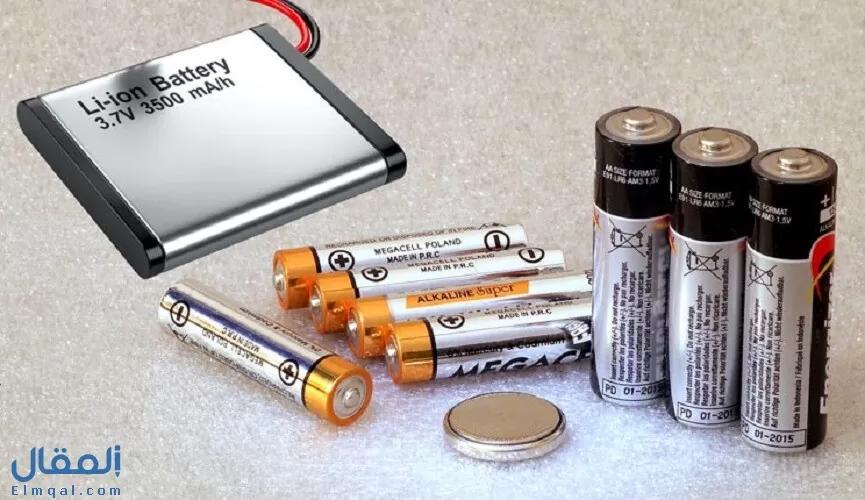A battery may consist of a single cell or a group of cells, which involve some of the chemical reactions that lead to the generation of electricity.
The need for batteries came as a result of the need to store energy for use when needed. Its use appeared in cases of power outages, as well as in cases of portable devices of various kinds and children's toys.
Batteries store direct current, but they cannot store alternating current.
The battery includes three main components as follows: -
- cathode is the negative pole
- elevator which is the positive pole.
Electronta is a substance that contains free ions to transmit electric current.
battery shapes
Batteries can be divided into several forms, according to their chemical composition, size and shape, to the following types: -
Primary batteries:-
They are single-use batteries, and they are not rechargeable, because the reactions in them cannot be reversed.
It has several different forms such as coin cell type and AA type.
This type is commonly used in military hardware.
This type also has a certain but high power limit, and the devices that are designed to work with it do not consume high power so the battery life lasts for a long time.
Examples of widespread devices that use this type of battery are the device used to regulate heart rate, wrist watches, trackers, children's toys, and remote control devices.
One of the most famous types is the alkaline battery, which is a good-cost battery, does not pollute the environment and does not leak charge, and it is also possible to carry it on planes safely.
The only drawback of this type is its low current, so it is only used in devices that need low current, such as portable devices, flashes, and sometimes lamps.
The second type of secondary batteries: -
This type includes electrochemical cells, so they are rechargeable again.
This is done by reversing the direction of the interactions in it.
This type is used by high-power devices, such as mobile phones and electric vehicles, and the high-capacity type is used as a backup source to generate electricity.
Its cost is higher than the initial type, but in the long run it is more economical.
It can be divided according to its chemical structure into several types, and the chemical structure is important in determining its price, energy, life cycle and storage life of the battery.
It can be divided into the following types:-
Nickel-cadmium batteries:
It is a type of rechargeable battery, which includes nickel oxide hydroxide and metallic cadmium.
It is distinguished by its preservation of voltage, and the preservation of its charge when not in use.
The disadvantage is that the battery is negatively affected, if it is partially charged.
When compared to other types of secondary batteries, we find that they perform better at lower temperatures.
Available in many sizes, and used singly or in combination, the smallest of them are used in portable devices of various kinds and children's toys, while the large size is used in devices for backup electricity, aircraft take-off batteries, as well as electric vehicles.
Its characteristics can be summarized as follows:-
Its power is known and defined

Its ability is limited
It is efficient in both charging and discharging
Its life cycle is about 2000 cycles.
Nickel-metal hydride batteries:
A type of rechargeable battery that also uses nickel oxide hydroxide, but instead of cadmium, negative electrons saturated with hydrogen are used.
They are found in devices with high consumption, due to their high power density and capacity.
It has a capacity of two to three times, for a nickel-cadmium battery.
It has no memory effect defect like nickel cadmium battery.
Its characteristics can be summarized as follows:-
Its energy is limited to 60-120h/kg
Its energy density: 140-300 Wh/L
Its capacity ranges from 66% - 92%
Battery charging and discharging ranges from 70-90%
Battery life in the range of 180 -2000
Lithium-ion batteries
The most common type of secondary battery is found in various portable devices such as phones, and laptops.
It is used in military and aviation purposes, due to its light weight.
In this type, the lithium material moves from the negative electron to the positive during the discharging process, and then back again to the negative during the charging process.
Its power is high, it has no memory defect, and its self-discharge is low compared to other types
Its cost varies depending on the purpose for which the battery will be used. The type used in portable devices uses lithium cobalt oxide, while the type used in medical and electrical devices uses the safer lithium iron phosphate.
Its characteristics can be summarized as follows:-
Power limited to 100: 265W-h/kg
Battery density 250: 693 Wh/
Its charge and discharge rate is 80-90%.
Battery self-discharge rate -2.9%/month at 20oC
Battery life 400: 1200 cycles:
Voltage NMC 3.6/3.85V
lead batteries
It is a kind of low-cost, high-performance battery.
Its size is huge, so it is not used in mobile devices.
They are used in generators, running lights and solar panels.
One of the oldest types of batteries, but it is still used today.
How to choose the right battery type
To choose the type of battery that suits you, you must take into account several factors as follows: -
